Lessons to Be Learned: Groundwater Depletion in Chile’s Ligua and Petorca Watersheds through an Interdisciplinary Approach
Abstract
1. Introduction
2. Materials and Methods
2.1. Study Area
2.2. Data Acquisition
2.2.1. GW and Rainfall Data
2.2.2. Satellite Data
2.2.3. GW Rights
2.3. Methods
2.3.1. GW, Rainfall, and GW Rights Processing
2.3.2. Drought Index
2.3.3. Normalized Difference Vegetation Index NDVI
2.3.4. Land Use/Land Cover Change LULCC
2.3.5. Statistical Tests and Correlation
3. Results
3.1. Temporal and Spatial Variation of GW and Rainfall
3.1.1. SPI-Based Drought Assessment
3.1.2. GW and Drought
3.2. NDVI Time Series Data Analyses
3.3. LULCC 2002–2017. Natural and Human Implications
3.4. GW Rights
3.5. Statistical Analyses
3.5.1. GW, Rainfall, and Vegetation Trend Tests
3.5.2. GW Correlation with Rainfall, Drought, Vegetation, and Human Factors. Cross Correlation and Cluster Analyses
4. Discussion
4.1. Assessment of GW Depletion and its Implicants
4.2. GW Resources Management in the Ligua and Petorca Watersheds
5. Conclusions
Author Contributions
Funding
Acknowledgments
Conflicts of Interest
References
- Mossa, S.; Parizi, E.; Ataie-Ashtiani, B.; Simmons, C.T. Assessment of sustainable groundwater resources management using integrated environmental index: Case studies across Iran. Sci. Total Environ. 2019, 676, 792–810. [Google Scholar] [CrossRef]
- Lee, J.M.; Kwon, E.H.; Woo, N.C. Natural and human-induced drivers of groundwater sustainability: A case study of the mangyeong river basin in korea. Sustainability 2019, 11, 1486. [Google Scholar] [CrossRef]
- Feng, W.; Shum, C.K.; Zhong, M.; Pan, Y. Groundwater storage changes in china from satellite gravity: An overview. Remote Sens. 2018, 10, 674. [Google Scholar] [CrossRef]
- Abou Zaki, N.; Torabi Haghighi, A.; Rossi, P.M.; Tourian, M.J.; Klove, B. Monitoring groundwater storage depletion using gravity recovery and climate experiment (GRACE) data in Bakhtegan Catchment, Iran. Water 2019, 11, 1456. [Google Scholar] [CrossRef]
- Loehman, E.T. Social investment for sustainability of groundwater: A revealed preference approach. Sustainability 2014, 6, 5598–5638. [Google Scholar] [CrossRef]
- Lee, J.M.; Park, J.H.; Chung, E.; Woo, N.C. Assessment of groundwater drought in the Mangyeong River Basin, Korea. Sustainability 2018, 10, 831. [Google Scholar] [CrossRef]
- Zou, L.; Xia, J.; She, D. Analysis of impacts of climate change and human activities on hydrological drought: A case study in the Wei River Basin, China. Water Resour. Manag. 2018, 32, 1421–1438. [Google Scholar] [CrossRef]
- Wilhite, D.A.; Glantz, M.H. Understanding: The drought phenomenon: The role of definitions. Water Int. 1985, 10, 111–120. [Google Scholar] [CrossRef]
- Chu, H.J. Drought detection of regional nonparametric standardized groundwater index. Water Resour. Manag. 2018, 32, 3119–3134. [Google Scholar] [CrossRef]
- Dai, M.; Huang, S.; Huang, Q.; Leng, G.; Guo, Y.; Wang, L.; Fang, W.; Li, P.; Zheng, X. Assessing agricultural drought risk and its dynamic evolution characteristics. Agric. Water Manag. 2020, 231, 106003. [Google Scholar] [CrossRef]
- Moiwo, J.P.; Tao, F. Evidence of land-use controlled water storage depletion in Hai River Basin, North China. Water Resour. Manag. 2014, 28, 4733–4746. [Google Scholar] [CrossRef]
- Lamichhane, S.; Shakya, N.M. Alteration of groundwater recharge areas due to land use/cover change in Kathmandu Valley, Nepal. J. Hydrol. Reg. Stud. 2019, 26, 100635. [Google Scholar] [CrossRef]
- Alley, W.; Leake, S. The journey from safe yield to sustainabilty. Groundwater 2004, 42, 12–16. [Google Scholar] [CrossRef] [PubMed]
- Bolados, P.; Henríquez, F.; Ceruti, C.; Sánchez, A. La eco-geo-política del agua: Una propuesta desde los territorios en las luchas por la recuperación del agua en la provincia de Petorca (Zona Central de Chile). Rupturas 2017, 8, 167–199. [Google Scholar] [CrossRef]
- Budds, J. La Demanda, Evaluación y Asignación del agua en el contexto de escasez: Un análisis del ciclo hidrosocial del Valle Del Río La Ligua, Chile. Rev. Geogr. Norte Gd. 2012, 52, 167–184. [Google Scholar] [CrossRef]
- Muñoz, A.A.; Klock-barría, K.; Alvarez-garreton, C.; Aguilera-betti, I.; González-reyes, Á.; Lastra, J.A.; Chávez, R.O.; Barría, P. Water crisis in Petorca Basin, Chile: The combined effects of a mega-drought and water management. Water 2020, 11, 648. [Google Scholar] [CrossRef]
- Panez-Pinto, A.; Faúndez-Vergara, R.; Mansilla-Quiñones, C. Politización de la crisis hídrica en Chile: Análisis del conflicto por el agua en La Provincia de Petorca. Agua Y Territ. 2017, 10, 131–148. [Google Scholar] [CrossRef]
- Banco Mundial. Diagnóstico de La Gestión de Los Recursos Hídricos; Banco Mundial: Santiago, Chile, 2011. [Google Scholar]
- Ayala; Cabrera; Asociados LTDA. Modelación Hidrogeológica de Los Acuíferos de Ligua y Petorca; DGA-MOP: Santiago, Chile, 2014.
- Celedón, E. Radiografía a la realidad hídrica de la Ligua y Petorca. Vertiente 2019, 20, 20–37. [Google Scholar]
- DGA-MOP (Dirección Nacional de Aguas y Ministerio de Obras Públicas). Declaración Zona de Escacez a La Provincia de Petorca, Región de Vaparaiso; DGA-MOP: Santiago, Chile, 2019.
- Panez-Pinto, A.; Mansilla-Quiñones, P.; Moreira-Muñoz, A. Agua, tierra y fractura sociometabólica del agronegocio. Actividad frutícola en Petorca, Chile. Bitácora 2018, 28, 153–160. [Google Scholar] [CrossRef]
- Roose, I.; Panez, A. Social innovations as a response to dispossession: Community water management in view of socio-metabolic rift in chile. Water 2020, 12, 566. [Google Scholar] [CrossRef]
- Ayala, F. Derecho Humano Al Agua En Chile ¿Qué Pasa Con El Acceso y La Priorización? Centro Democracia y Comunidad: Santiago, Chile, 2016; Volume 13. [Google Scholar]
- Bolados, P. Conflictos socio-ambientales/territoriales y el surgimiento de identidades post neoliberales (Valparaíso-Chile). Izquierdas 2016, 31, 102–129. [Google Scholar] [CrossRef]
- CNR-UDEC (Comisión Nacional de Riego y Universidad de Concepción). Estudio Básico Diagnóstico Para Desarrollar Plan de Riego en Las Cuencas de Los Ríos La Ligua y Petorca; Informe Final CNR-UDEC: Chillán, Chile, 2016. [Google Scholar]
- DGA-MOP (Dirección General de Aguas y Ministerio de Obras Públicas). Determinación de Los Sectores Hidrogeológicos de Aprovechamiento Común, Áreas de Restricción, Acuíferos de Los Ríos Petorca y La Ligua; DARH SDT N° 352: Santiago, Chile, 2014.
- Alvarez-Garreton, C.; Mendoza, P.A.; Pablo Boisier, J.; Addor, N.; Galleguillos, M.; Zambrano-Bigiarini, M.; Lara, A.; Puelma, C.; Cortes, G.; Garreaud, R.; et al. The CAMELS-CL Dataset: Catchment attributes and meteorology for large sample studies-chile dataset. Hydrol. Earth Syst. Sci. 2018, 22, 5817–5846. [Google Scholar] [CrossRef]
- Bozkurt, D.; Rojas, M.; Boisier, J.P.; Rondanelli, R.; Garreaud, R.; Gallardo, L. Dynamical downscaling over the complex terrain of southwest South America: Present climate conditions and added value analysis. Clim. Dyn. 2019, 0123456789. [Google Scholar] [CrossRef]
- Didan, K. MOD13Q1 MODIS/Terra Vegetation Indices 16-Day L3 Global 250m SIN Grid V006 [Data Set]. NASA EOSDIS Land Processes DAAC; 2015. Available online: https://lpdaac.usgs.gov/products/mod13q1v006/ (accessed on 2 May 2019).
- Dong, S.; Li, H.; Sun, D. Fractal feature analysis and information extraction of woodlands based on MODIS NDVI time series. Sustainability 2017, 9, 1215. [Google Scholar] [CrossRef]
- DGA-MOP (Dirección General de Aguas y Ministerio de Obras Públicas). Manual de Normas y Procedimientos Para La Administración de Recursos Hídricos; S.I.T N° 156: Santiago, Chile, 2008.
- Hu, K.X.; Awange, J.L.; Kuhn, M.; Saleem, A. Spatio-temporal groundwater variations associated with climatic and anthropogenic impacts in south-west western Australia. Sci. Total Environ. 2019, 696, 1–18. [Google Scholar] [CrossRef]
- McKee, T.; Doesken, N.; Kleist, J. The Relationship of Drought Frequency and Duration to Time Scales. In Proceedings of the 8th Conference on Applied Climatology, Anaheim, CA, USA, 17–22 January 1993; American Meteorological Society: Boston, MA, USA, 1993; pp. 179–184. [Google Scholar] [CrossRef]
- Lorenzo-Lacruz, J.; Garcia, C.; Morán-Tejeda, E. Groundwater level responses to precipitation variability in Mediterranean Insular Aquifers. J. Hydrol. 2017, 552, 516–531. [Google Scholar] [CrossRef]
- Shahid, S.; Hazarika, M.K. Groundwater drought in the northwestern districts of Bangladesh. Water Resour. Manag. 2010, 24, 1989–2006. [Google Scholar] [CrossRef]
- Wable, P.S.; Jha, M.K.; Shekhar, A. Comparison of drought indices in a semi-arid river basin of India. Water Resour. Manag. 2019, 33, 75–102. [Google Scholar] [CrossRef]
- Caccamo, G.; Chisholm, L.A.; Bradstock, R.A.; Puotinen, M.L. Assessing the Sensitivity of MODIS to monitor drought in high biomass ecosystems. Remote Sens. Environ. 2011, 115, 2626–2639. [Google Scholar] [CrossRef]
- WMO-GWP (World Meteorological Organization and Global Water Partnership). Handbook of Drought Indicators and Indices; Svoboda, M., Fuchs, B., Eds.; Integrated Drought Management Tools and Guidelines Series 2: Geneva, Switzerland, 2016. [Google Scholar]
- Zambrano-Bigiarini, M.; Nauditt, A.; Birkel, C.; Verbist, K.; Ribbe, L. Temporal and spatial evaluation of satellite-based rainfall estimates across the complex topographical and climatic gradients of Chile. Hydrol. Earth Syst. Sci. 2017, 21, 1295–1320. [Google Scholar] [CrossRef]
- Zhang, A.; Jia, G. Monitoring meteorological drought in semiarid regions using multi-sensor microwave remote sensing data. Remote Sens. Environ. 2013, 134, 12–23. [Google Scholar] [CrossRef]
- Zheng, K.; Wei, J.Z.; Pei, J.Y.; Cheng, H.; Zhang, X.L.; Huang, F.Q.; Li, F.M.; Ye, J.S. Impacts of climate change and human activities on grassland vegetation variation in the Chinese Loess plateau. Sci. Total Environ. 2019, 660, 236–244. [Google Scholar] [CrossRef]
- Yao, N.; Li, Y.; Lei, T.; Peng, L. Drought evolution, severity and trends in mainland China over 1961–2013. Sci. Total Environ. 2018, 616–617, 73–89. [Google Scholar] [CrossRef]
- Wingate, V.R.; Phinn, S.R.; Kuhn, N. Mapping precipitation-corrected NDVI trends across Namibia. Sci. Total Environ. 2019, 684, 96–112. [Google Scholar] [CrossRef]
- Gorelick, N.; Hancher, M.; Dixon, M.; Ilyushchenko, S.; Thau, D.; Moore, R. Google Earth Engine: Planetary-scale geospatial analysis for everyone. Remote Sens. Environ. 2017, 202, 18–27. [Google Scholar] [CrossRef]
- Zurqani, H.A.; Post, C.J.; Mikhailova, E.A.; Schlautman, M.A.; Sharp, J.L. Geospatial analysis of land use change in the Savannah river basin using Google Earth Engine. Int. J. Appl. Earth Obs. Geoinf. 2018, 69, 175–185. [Google Scholar] [CrossRef]
- Richter, R.; Kellenberger, T.; Kaufmann, H. Comparison of topographic correction methods. Remote Sens. 2009, 1, 184–196. [Google Scholar] [CrossRef]
- Chander, G.; Markham, B.L.; Helder, D.L. Summary of current radiometric calibration coefficients for Landsat MSS, TM, ETM+, and EO-1 ALI Sensors. Remote Sens. Environ. 2009, 113, 893–903. [Google Scholar] [CrossRef]
- Chavez, P.S. An improved dark-object subtraction technique for atmospheric scattering correction of multispectral data. Remote Sens. Environ. 1988, 24, 459–479. [Google Scholar] [CrossRef]
- Zhao, Y.; Feng, D.; Yu, L.; Wang, X.; Chen, Y.; Bai, Y.; Hernández, H.J.; Galleguillos, M.; Estades, C.; Biging, G.S.; et al. Detailed dynamic land cover mapping of Chile: Accuracy improvement by integrating multi-temporal data. Remote Sens. Environ. 2016, 183, 170–185. [Google Scholar] [CrossRef]
- Gounaridis, D.; Chorianopoulos, I.; Symeonakis, E.; Koukoulas, S. A random forest-cellular automata modelling approach to explore future land use/cover change in Attica (Greece), under different socio-economic realities and scales. Sci. Total Environ. 2019, 646, 320–335. [Google Scholar] [CrossRef]
- Breiman, L. Random Forests. Mach. Learn. 2001, 45, 5–32. [Google Scholar] [CrossRef]
- Mbaabu, P.R.; Ng, W.T.; Schaffner, U.; Gichaba, M.; Olago, D.; Choge, S.; Oriaso, S.; Eckert, S. Spatial evolution of prosopis invasion and its effects on LULC and livelihoods in Baringo, Kenya. Remote Sens. 2019, 11, 1217. [Google Scholar] [CrossRef]
- Zhang, H.; Li, Q.; Liu, J.; Du, X.; Mc Naim, H.; Champagne, C.; Dong, T.; Liu, M. Image classification using RapidEye Data: Integration of spectral and textual features in a random forest classifier. IEEE J. Sel. Top. Appl. Earth Obs. Remote Sens. 2017, 10, 5334–5349. [Google Scholar] [CrossRef]
- Kendall, M. Rank Correlation Methods; Charles Griffin: London, UK, 1975. [Google Scholar]
- Mann, H.B. Nonparametric tests against trend. Econometrica 1945, 13, 245–259. [Google Scholar] [CrossRef]
- Sen, P.K. Estimates of the regression coefficient based on Kendall’s Tau. J. Am. Stat. Assoc. 1968, 63, 1379–1389. [Google Scholar] [CrossRef]
- Zoungrana, B.J.B.; Conrad, C.; Thiel, M.; Amekudzi, L.K.; Da, E.D. MODIS NDVI Trends and Fractional land cover change for improved assessments of vegetation degradation in Burkina Faso, West Africa. J. Arid Environ. 2018, 153, 66–75. [Google Scholar] [CrossRef]
- Pettitt, A. A non-parametric approach to the change-point problem. Appl. Stat. 1979, 28, 126–135. [Google Scholar] [CrossRef]
- Chen, T.; Bao, A.; Jiapaer, G.; Guo, H.; Zheng, G.; Jiang, L.; Chang, C.; Tuerhanjiang, L. Disentangling the relative impacts of climate change and human activities on arid and semiarid grasslands in central Asia during 1982–2015. Sci. Total Environ. 2019, 653, 1311–1325. [Google Scholar] [CrossRef]
- AGRIMED. Atlas Del Cambio Climático En Las Zonas de Régimen Árido y Semiárido; Universidad de Chile: Santiago, Chile, 2014. [Google Scholar]
- World Meteorological Organization (WMO). Guide to Climatological Practices; WMO: Geneva, Switzerland, 2018. [Google Scholar]
- Garreaud, R.; Alvarez-Garreton, C.; Barichivich, J.; Boisier, J.P.; Christie, D.; Galleguillos, M.; LeQuesne, C.; McPhee, J.; Zambrano-Bigiarini, M. The 2010–2015 mega drought in central Chile: Impacts on regional hydroclimate and vegetation. Hydrol. Earth Syst. Sci. 2017, 1–18. [Google Scholar] [CrossRef]
- Garreaud, R.D.; Boisier, J.P.; Rondanelli, R.; Montecinos, A.; Sepúlveda, H.H.; Veloso-Aguila, D. The central Chile mega drought (2010–2018): A climate dynamics perspective. Int. J. Climatol. 2019, 40, 421–439. [Google Scholar] [CrossRef]
- Aldunce, P.; Araya, D.; Sapiain, R.; Ramos, I.; Lillo, G.; Urquiza, A.; Garreaud, R. Local perception of drought impacts in a changing climate: The mega-drought in central Chile. Sustainability 2017, 9, 2053. [Google Scholar] [CrossRef]
- Bozkurt, D.; Rojas, M.; Boisier, J.P.; Valdivieso, J. Climate change impacts on hydroclimatic regimes and extremes over Andean basins in central Chile. Hydrol. Earth Syst. Sci. 2017, 1–29. [Google Scholar] [CrossRef]
- Carr, M.K.V. The water relations and irrigation requirements of avocado (Persea Americana Mill.): A review. Exp. Agric. 2013, 49, 256–278. [Google Scholar] [CrossRef]
- Holzapfel, E.; de Souza, J.A.; Jara, J.; Guerra, H.C. Responses of avocado production to variation in irrigation levels. Irrig. Sci. 2017, 35, 205–215. [Google Scholar] [CrossRef]
- INIA (Instituto de Investigaciones Agropecuarias). Manual Del Cultivo Del Palto; Torres, A., Ed.; Boletín INIA N° 13: Santiago, Chile, 2017. [Google Scholar]
- Moreno-Ortega, G.; Pliego, C.; Sarmiento, D.; Barceló, A.; Martínez-Ferri, E. Yield and fruit quality of avocado trees under different regimes of water supply in the subtropical coast of Spain. Agric. Water Manag. 2019, 221, 192–201. [Google Scholar] [CrossRef]
- Red Agrícola. Un Desafío Pendiente: La Organización de Comunidades de Aguas Subterráneas. In Red Agrícola; Especial Agua y Riego N°46: Santiago, Chile, 2019; p. 4. [Google Scholar]
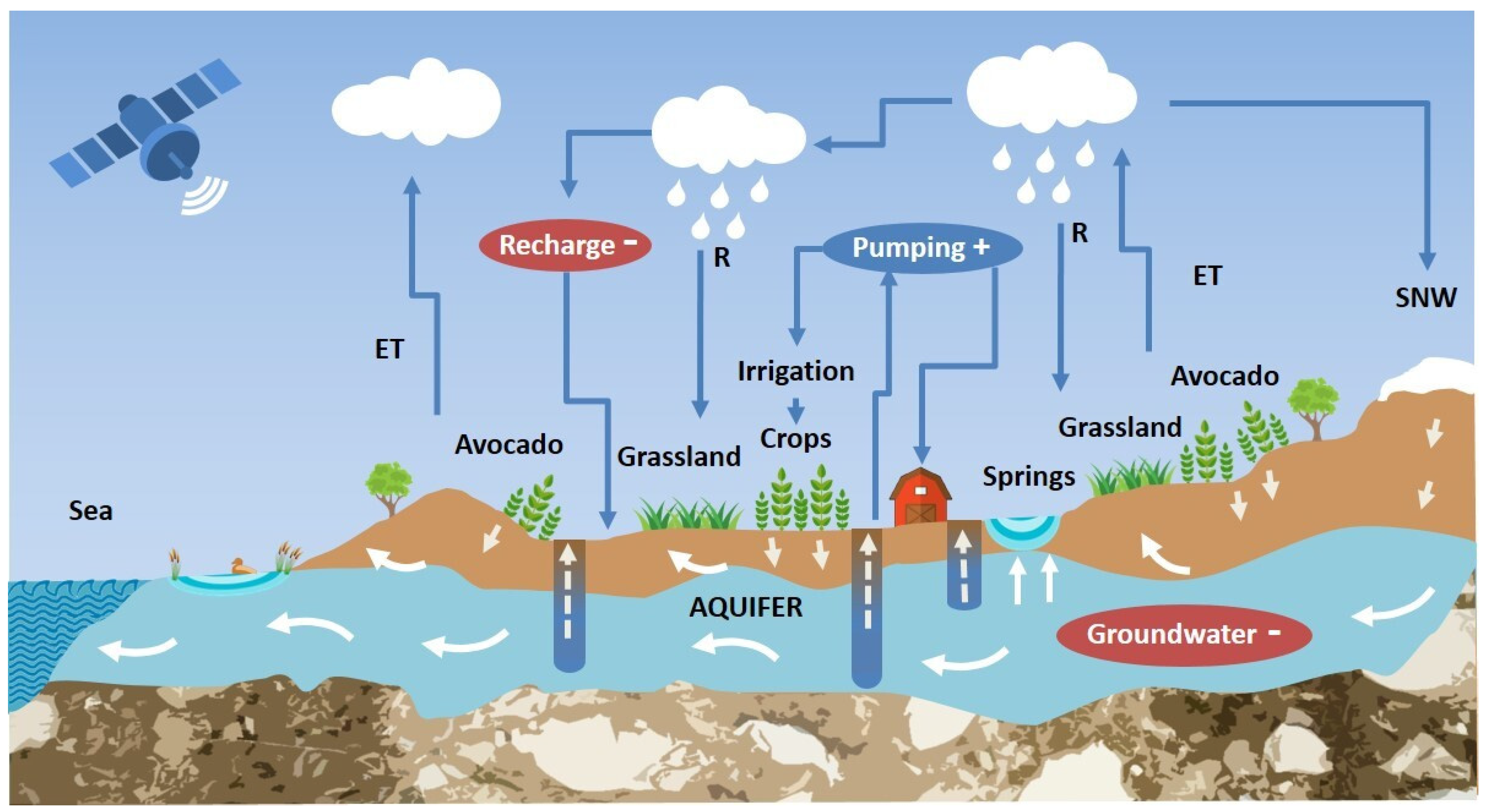
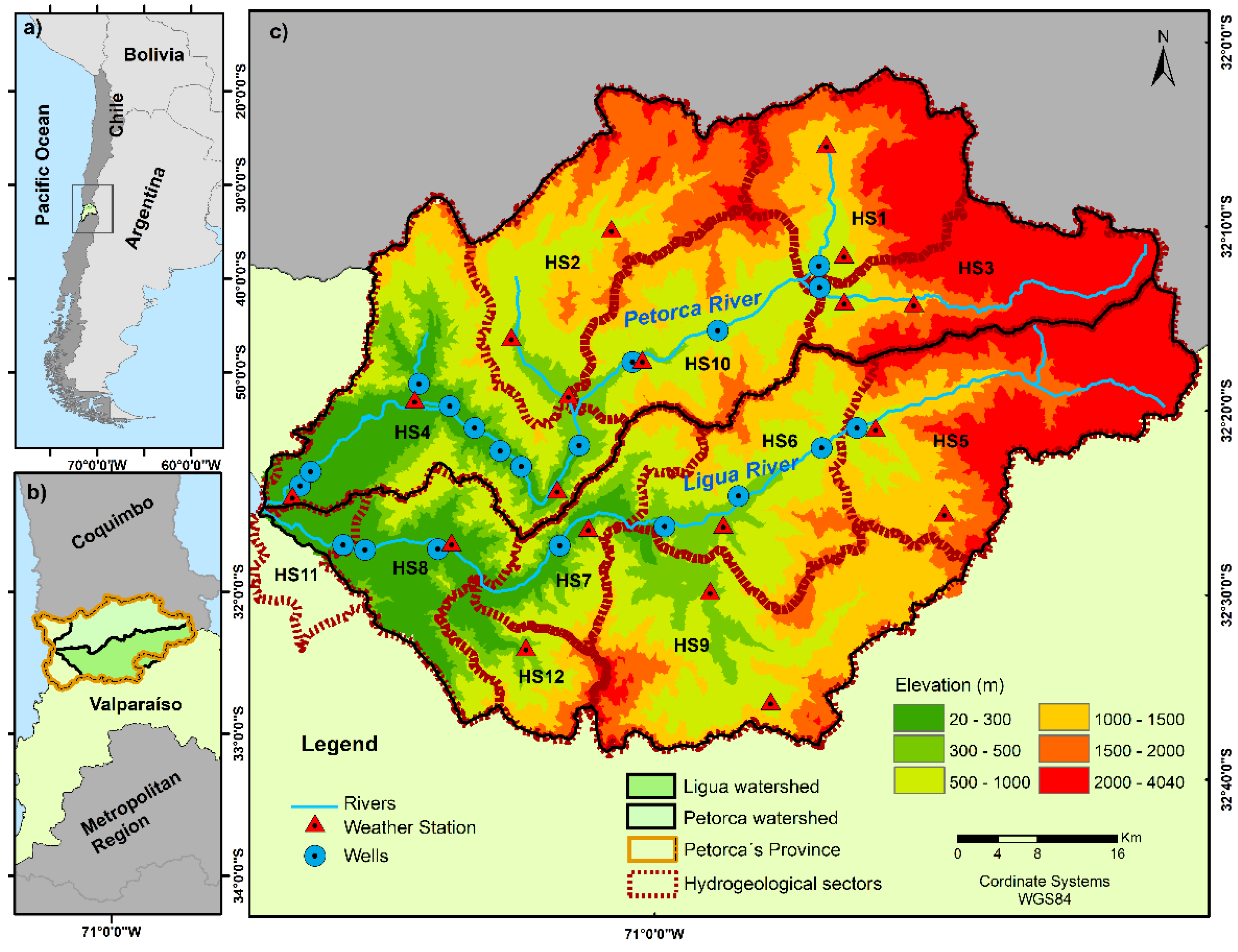
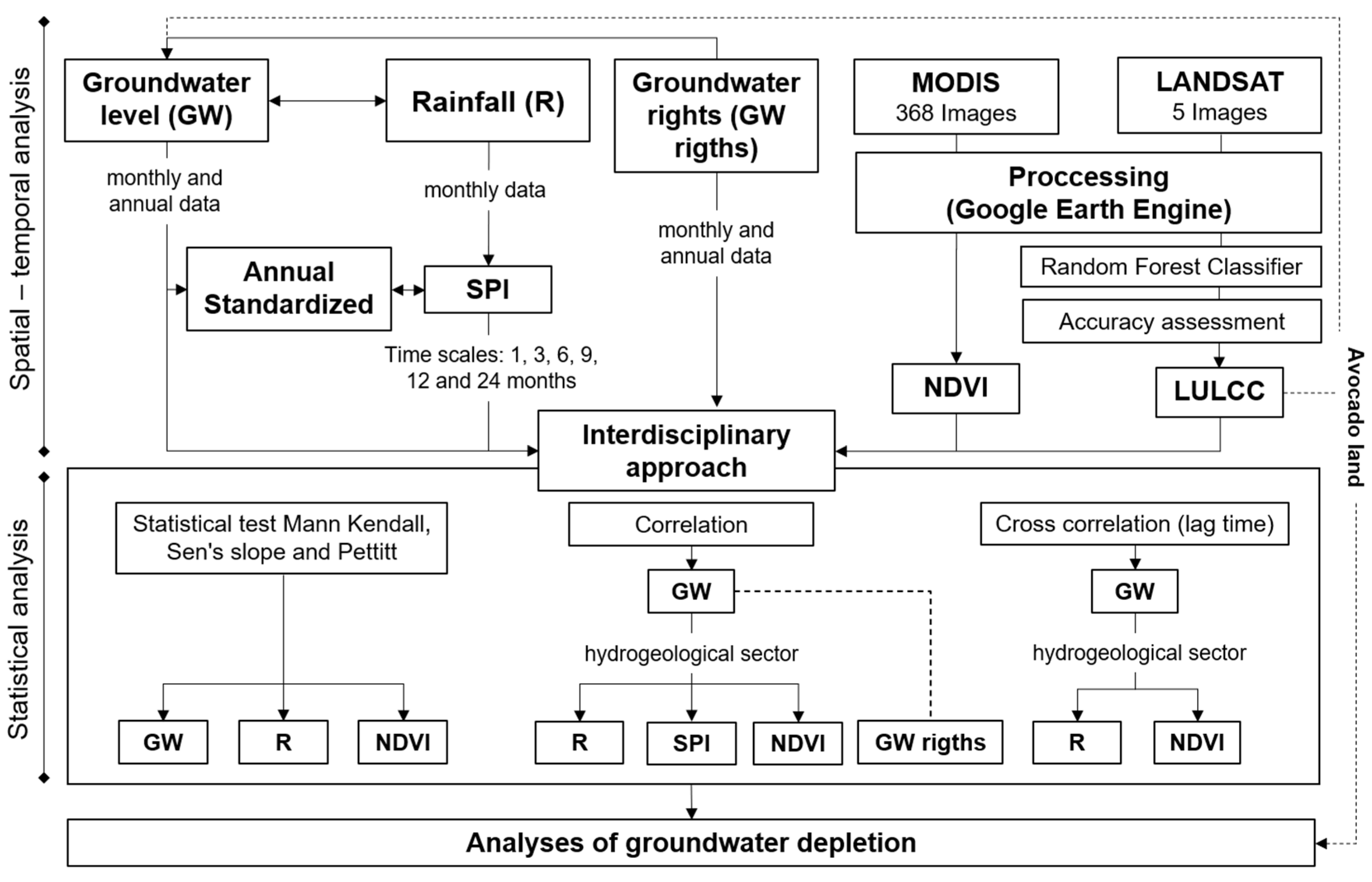

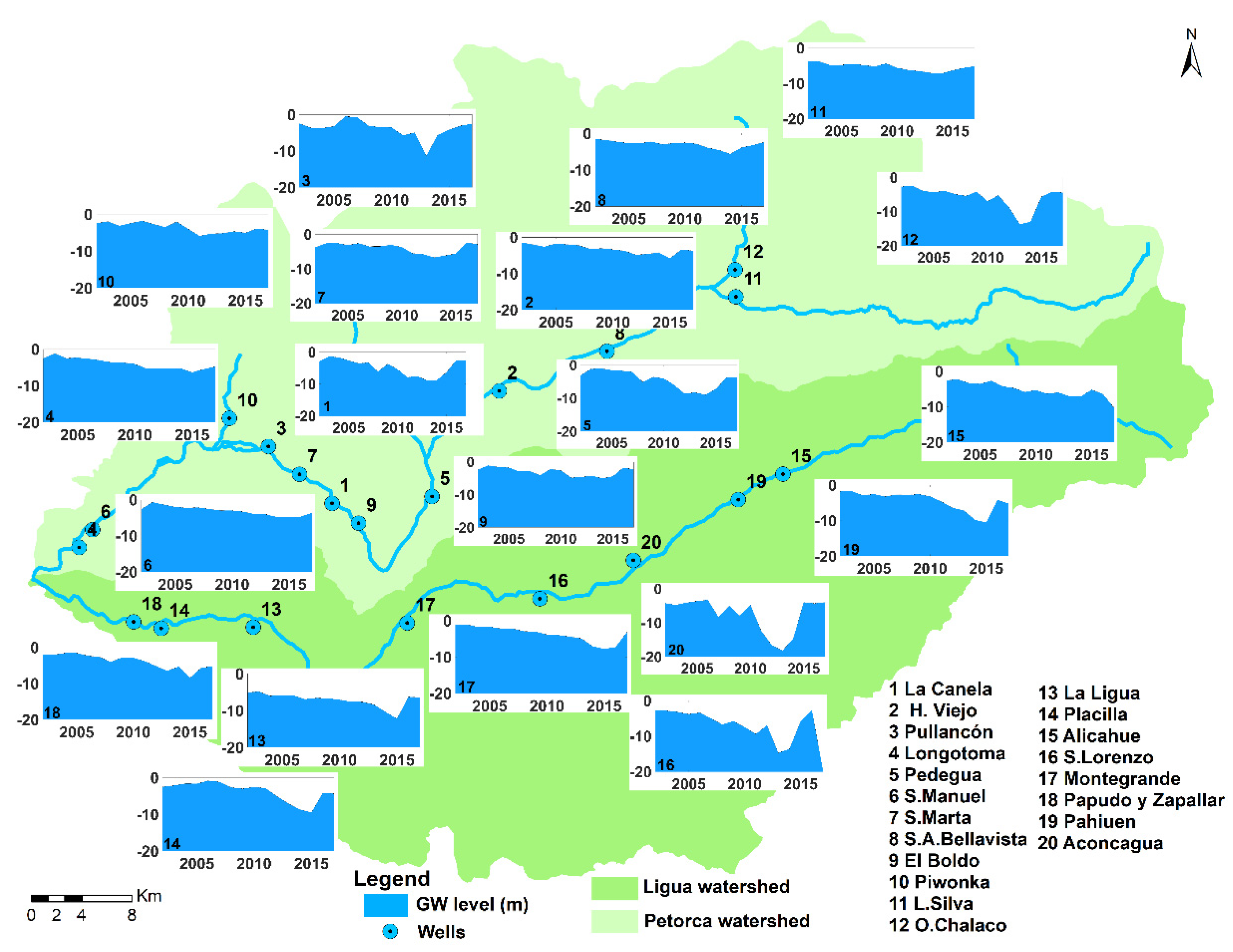
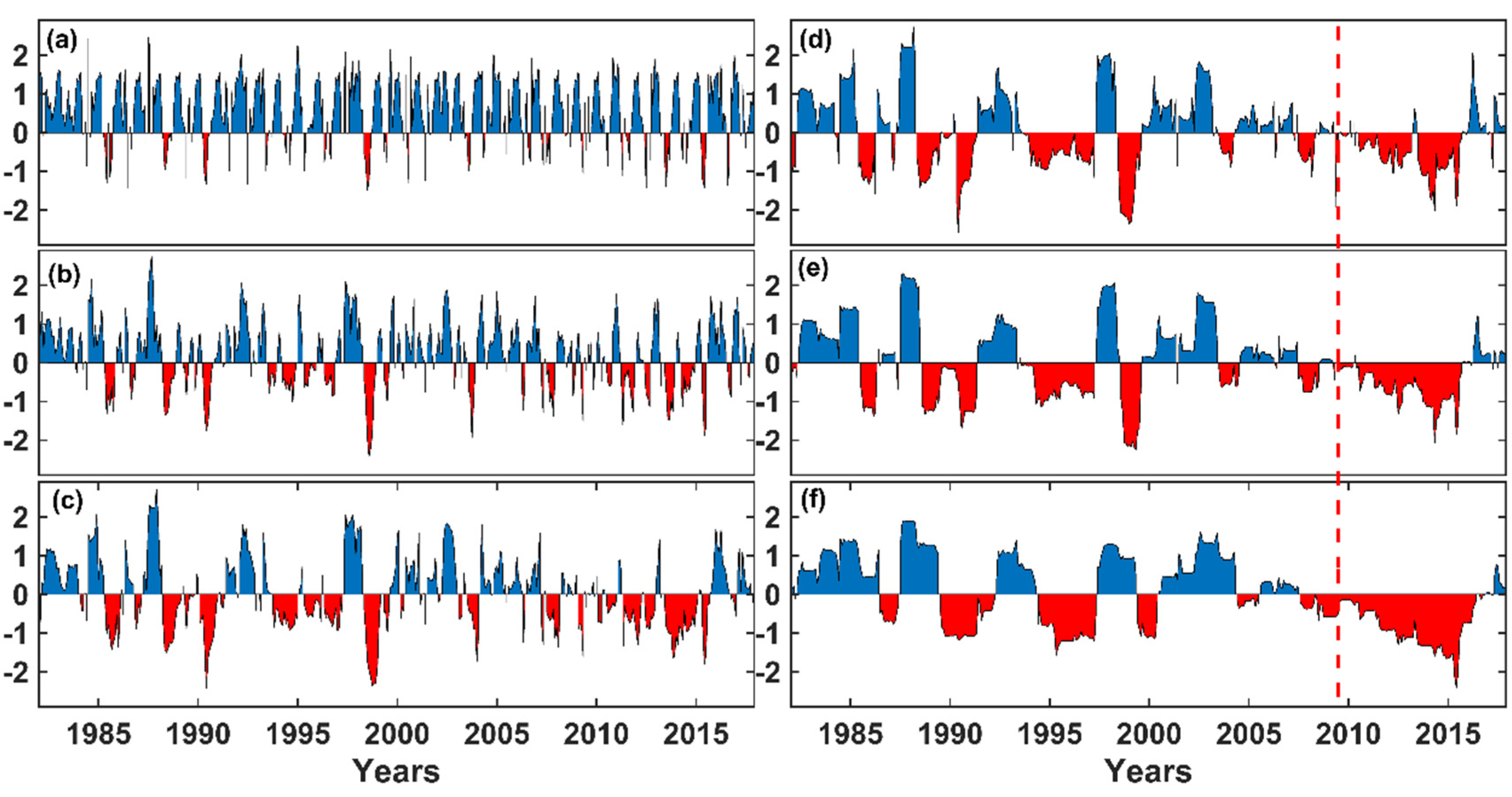


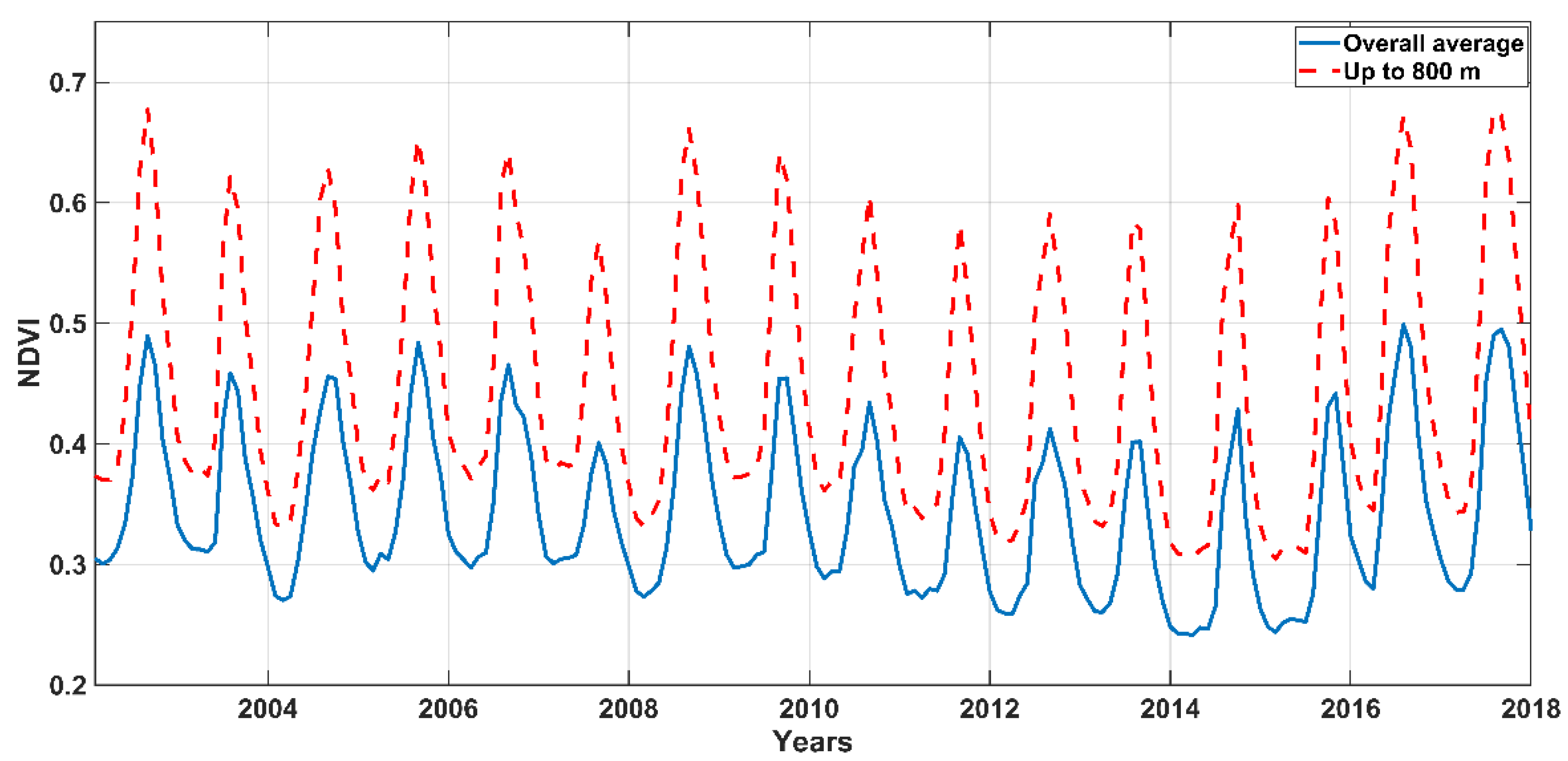


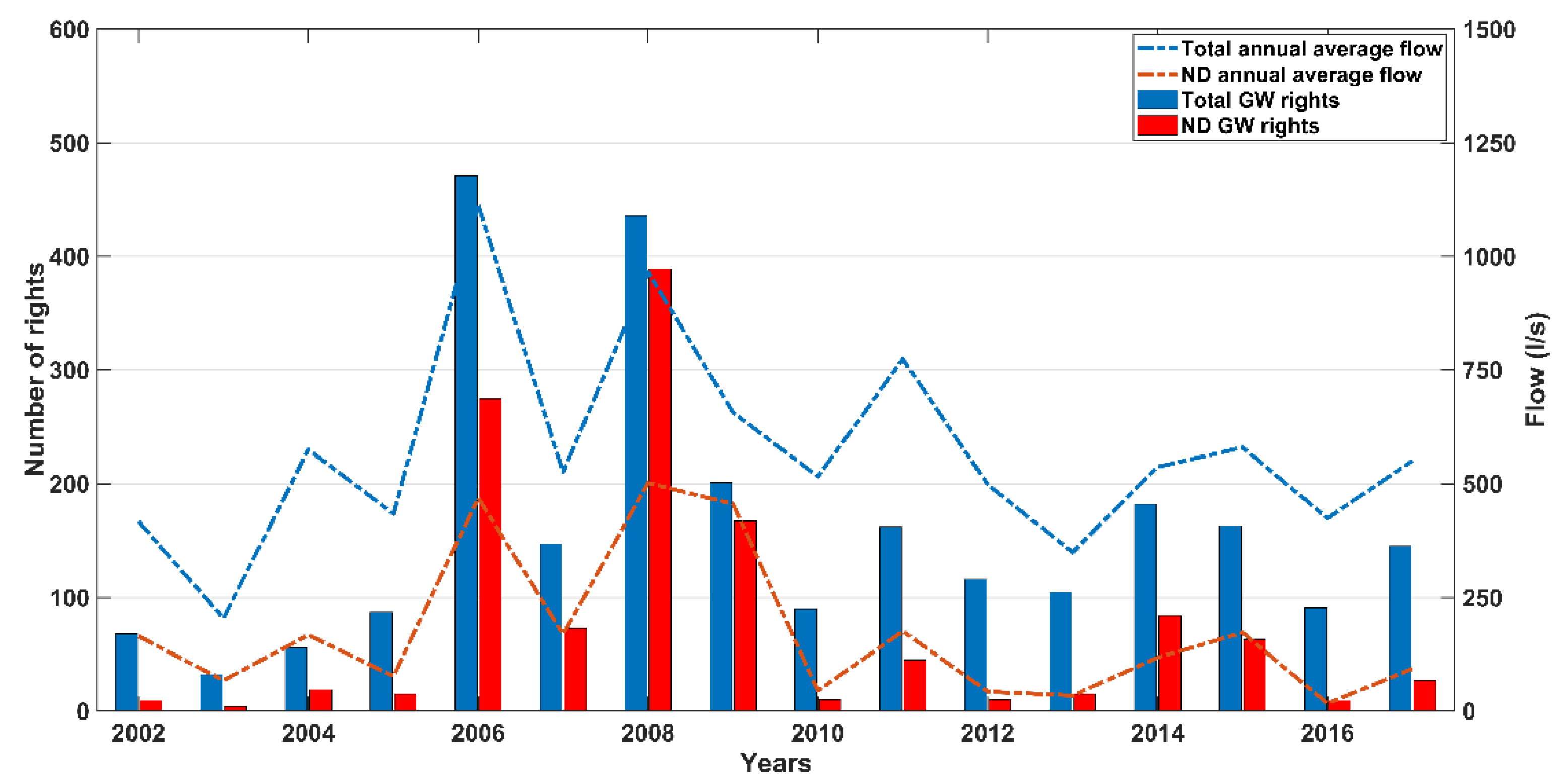
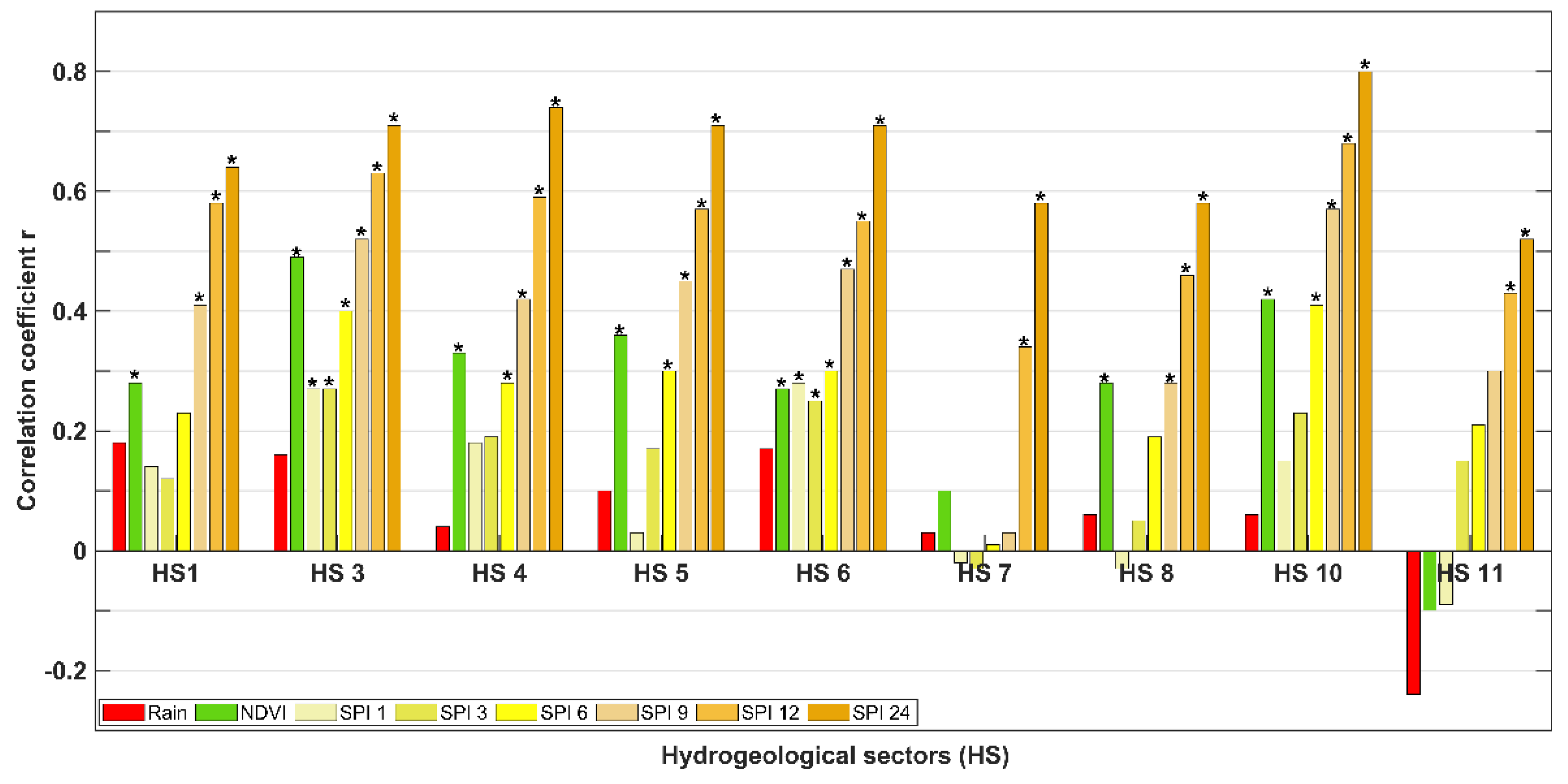
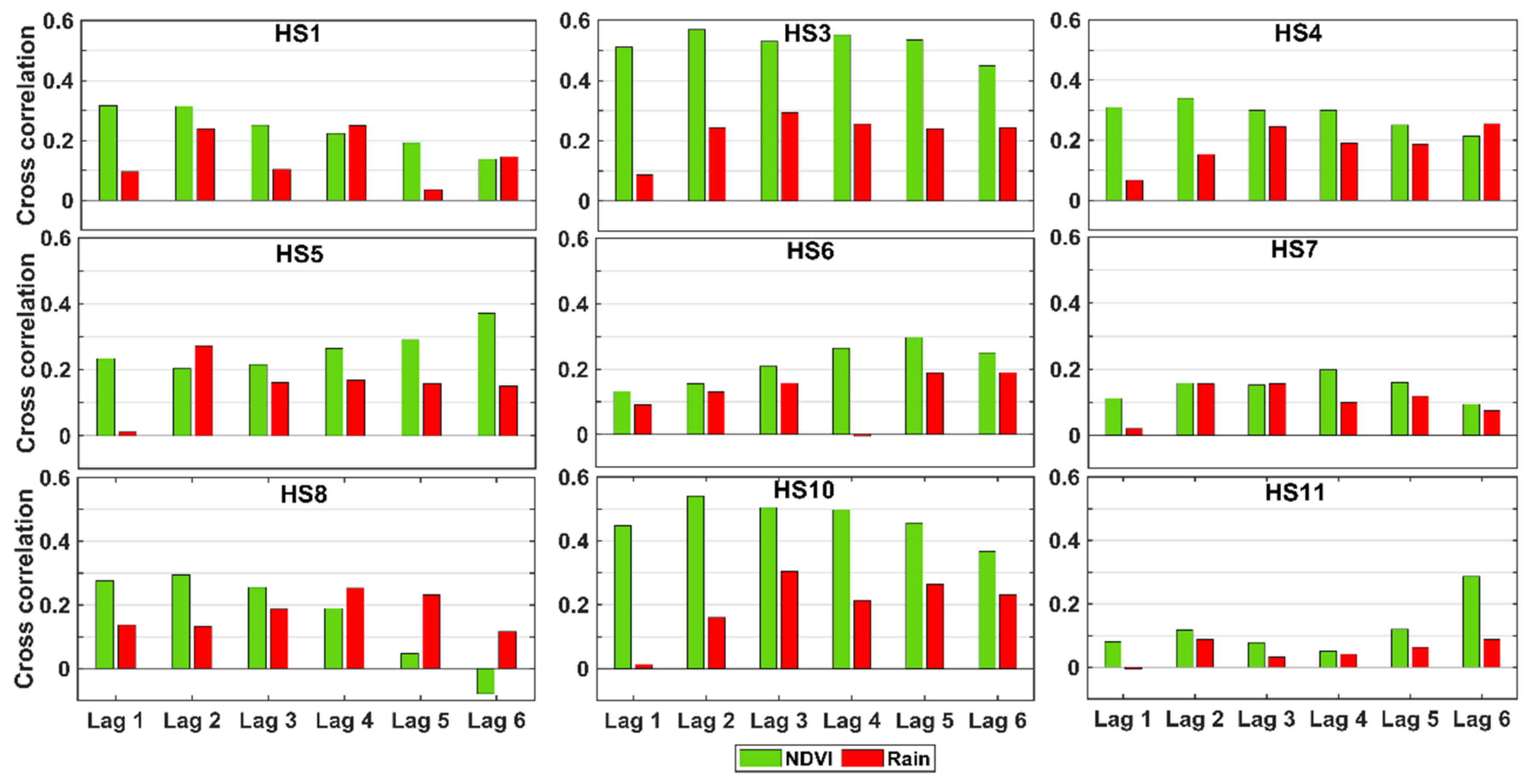
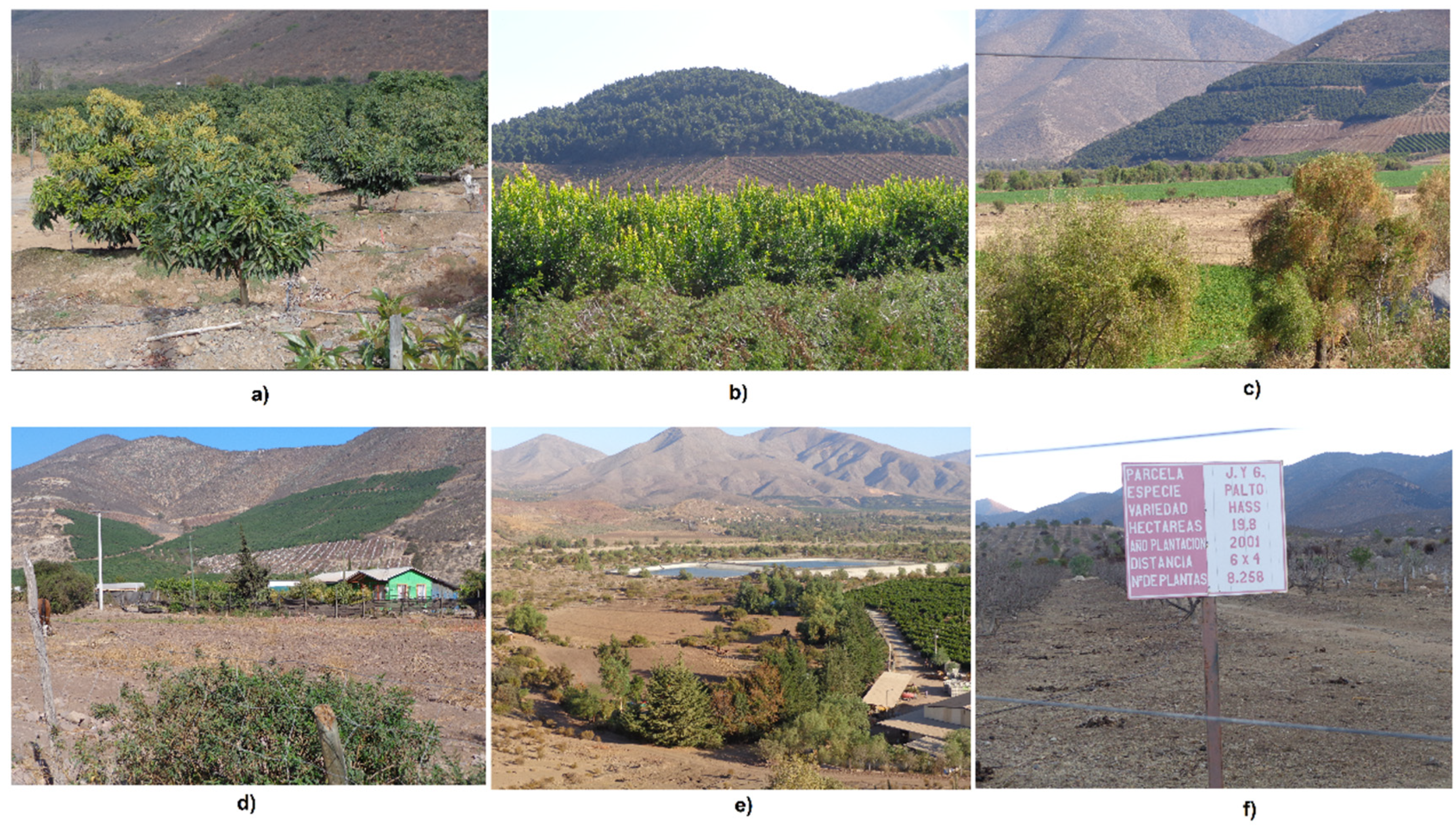
| Date | Path and Row | Sector | Sensor Type | |
|---|---|---|---|---|
| 21 March 2002 | 233 | 82 | Northern, headwaters, and middle sectors of the watersheds | Landsat 7 ETM+ |
| 21 March 2002 | 233 | 83 | Southern, headwaters, and middle sectors of the watersheds | Landsat 7 ETM+ |
| 20 March 2002 | 01 | 82 | Western and lower sectors of the watersheds | Landsat 5 TM |
| 1 January 2017 | 233 | 82 | Northern, headwaters, middle, and lower sectors of the watersheds | Landsat 8 OLI |
| 1 January 2017 | 233 | 83 | Southern, headwaters, middle, and lower sectors of the watersheds | Landsat 8 OLI |
| Name | Description |
|---|---|
| Fruit land | Cultivation of fruit trees such as lemon, orange, and walnut, among others |
| Avocado land | Cultivation of mature and young avocado trees |
| Agricultural land | Traditional agriculture, dominated by vegetable plantations and prairie crop rotation |
| Bare soil | Soil with little or no vegetation. Includes rocky areas |
| Scrubland | Bush areas, generally dominated by sclerophyll arborescent shrubs |
| Native forest | Native forest, essentially sclerophyll |
| Exotic plantation | Forestry plantation, dominated by the species Eucalyptus and Pinus radiata |
| Water bodies | Natural water bodies such as rivers, estuaries, ponds, and lakes |
| Reservoirs | Water stored artificially in ponds and reservoirs |
| Urban | Urban land associated with the urban fabric, manufacturing, highways, and roads |
| Classified Image | Overall Accuracy | Kappa |
|---|---|---|
| 21 March 2002 | 93.28 | 0.92 |
| 21 March 2002 | 92.73 | 0.92 |
| 20 March 2002 | 93.12 | 0.92 |
| 1 January 2017 | 90.88 | 0.90 |
| 1 January 2017 | 91.64 | 0.90 |
| Land-Use and Land-Cover Category | Changes (Ha) | Net Change (Ha) | |
|---|---|---|---|
| Losses (Ha) | Gains (Ha) | ||
| Fruit land | −1252 | 1669 | 417 |
| Avocado land | −2567 | 5062 | 2495 |
| Agricultural land | −4436 | 1574 | −2863 |
| Bare soil | −5865 | 20,541 | 14,676 |
| Scrubland | −21,240 | 27,474 | 6234 |
| Native forest | −23,607 | 2427 | −21,180 |
| Exotic plantation | −174 | 244 | 69 |
| Water bodies | −45 | 0 | −45 |
| Reservoirs | −92 | 112 | 19 |
| Urban land | −27 | 204 | 177 |
| PETORCA | LIGUA | ||||||||
|---|---|---|---|---|---|---|---|---|---|
| Wells and Seasons | Mann Kendall and Sen’s Slope | Pettitt | Wells and Seasons | Mann Kendall and Sen’s Slope | Pettitt | ||||
| p-Value | Slope Value | p-Value | Change Point | p-Value | Slope Value | p-Value | Change Point | ||
| La Canela | 0.03 | −0.40 | 0.11 | 2007 | La Ligua | 0.00 | −0.28 | 0.01 | 2006 |
| H. Viejo | 0.00 | −0.24 | 0.00 | 2009 | Placilla | 0.00 | −0.33 | 0.00 | 2008 |
| Pullancón | 0.26 | −0.13 | 0.18 | 2009 | Alicahue | 0.00 | −0.38 | 0.00 | 2008 |
| Longotoma | 0.00 | −0.31 | 0.00 | 2009 | |||||
| Pedegua | 0.00 | −0.43 | 0.00 | 2007 | S. Lorenzo | 0.00 | −0.64 | 0.05 | 2007 |
| S. Manuel | 0.00 | −0.27 | 0.00 | 2008 | Papudo y Zapallar | 0.00 | −0.33 | 0.00 | 2010 |
| S. Marta | 0.16 | −0.18 | 0.34 | 2009 | |||||
| S.Bellavista | 0.01 | −0.14 | 0.03 | 2010 | F.Montegrande | 0.00 | −0.39 | 0.00 | 2009 |
| El Boldo | 0.06 | −0.18 | 0.17 | 2005 | |||||
| Piwonka | 0.02 | −0.20 | 0.00 | 2009 | Pahiuen | 0.00 | −0.34 | 0.00 | 2010 |
| L. Silva | 0.00 | −0.20 | 0.00 | 2009 | Aconcagua | 0.37 | −0.10 | 0.22 | 2006 |
| O. Chalaco | 0.01 | −0.29 | 0.02 | 2009 | |||||
| DJF | 0.00 | −0.32 | 0.00 | 2009 | DJF | 0.02 | −0.19 | 0.02 | 2009 |
| MAM | 0.00 | −0.26 | 0.00 | 2009 | MAM | 0.00 | −0.39 | 0.00 | 2008 |
| JJA | 0.01 | −0.24 | 0.03 | 2007 | JJA | 0.00 | −0.43 | 0.00 | 2007 |
| SON | 0.00 | −0.26 | 0.01 | 2007 | SON | 0.00 | −0.29 | 0.00 | 2009 |
| 1 Class | Objects | Sum of Weights | Within-Class Variance | Minimum Distance to Centroid | Average Distance to Centroid | Maximum Distance to Centroid |
|---|---|---|---|---|---|---|
| 1 | 5 | 5 | 40.82 | 4.33 | 5.52 | 8.34 |
| 2 | 12 | 12 | 23.87 | 2.34 | 4.34 | 8.29 |
| 3 | 3 | 3 | 142.03 | 7.38 | 9.59 | 11.35 |
© 2020 by the authors. Licensee MDPI, Basel, Switzerland. This article is an open access article distributed under the terms and conditions of the Creative Commons Attribution (CC BY) license (http://creativecommons.org/licenses/by/4.0/).
Share and Cite
Duran-Llacer, I.; Munizaga, J.; Arumí, J.L.; Ruybal, C.; Aguayo, M.; Sáez-Carrillo, K.; Arriagada, L.; Rojas, O. Lessons to Be Learned: Groundwater Depletion in Chile’s Ligua and Petorca Watersheds through an Interdisciplinary Approach. Water 2020, 12, 2446. https://doi.org/10.3390/w12092446
Duran-Llacer I, Munizaga J, Arumí JL, Ruybal C, Aguayo M, Sáez-Carrillo K, Arriagada L, Rojas O. Lessons to Be Learned: Groundwater Depletion in Chile’s Ligua and Petorca Watersheds through an Interdisciplinary Approach. Water. 2020; 12(9):2446. https://doi.org/10.3390/w12092446
Chicago/Turabian StyleDuran-Llacer, Iongel, Juan Munizaga, José Luis Arumí, Christopher Ruybal, Mauricio Aguayo, Katia Sáez-Carrillo, Loretto Arriagada, and Octavio Rojas. 2020. "Lessons to Be Learned: Groundwater Depletion in Chile’s Ligua and Petorca Watersheds through an Interdisciplinary Approach" Water 12, no. 9: 2446. https://doi.org/10.3390/w12092446
APA StyleDuran-Llacer, I., Munizaga, J., Arumí, J. L., Ruybal, C., Aguayo, M., Sáez-Carrillo, K., Arriagada, L., & Rojas, O. (2020). Lessons to Be Learned: Groundwater Depletion in Chile’s Ligua and Petorca Watersheds through an Interdisciplinary Approach. Water, 12(9), 2446. https://doi.org/10.3390/w12092446





